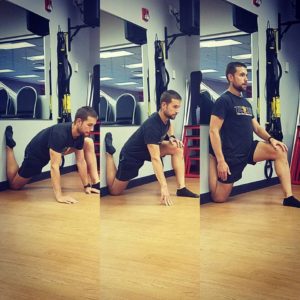By Aaron Boike, B.S. Kinesiology, ACE CPT, ACE Certified Health Coach
Okay, okay…so the title to this post has a pretty bold claim, but I really mean every word of it. In our modern day desk bound high-tech world, we spend a LOT of time sitting. Sitting isn’t inherently bad, it is a natural position. The problem is that we do it so frequently, and for so much of the day, that our bodies actually morph to accommodate the position. This means tight hip flexors and quadriceps, short and tightened hamstrings, and weak glutes and lumbar muscles that are nearly impossible to engage.
So what happens when we get active? Pain! Knee pain, hip pain, back pain, ankle and foot pain, and more. The position our hips gravitate towards when exposed to a lot of sitting is called an anterior pelvic tilt. This means the pelvis has literally shifted forward, over stretching the hamstrings and gastrocnemius (part of the calves), and further tightening the hip flexors and quads. This hip position makes it difficult if not impossible to engage the powerhouse that sits on your rear, the glutes! Without glute engagement in everyday exercises from walking to cycling, our knees take on extra stress, and that stress works it’s way up the chain for most people, ending up bothering the hips and low back.
Now I’d considering myself a pretty active person, and I have been since I was about 18 years old. However, years of college studying, desk jobs, and general leisure sitting time had left me, too, with a anterior pelvic tilt. Even after years of proper weightlifting, I found it very difficult to engage my glutes in everyday exercises like squats, lunges, deadlifts, as well as during walking and running. As I grew into an endurance athlete, this really started to catch up with me in the form of hip flexor and hamstring strains, and occasionally, knee pain. I was introduced to the Couch Stretch via Kelly Starrett’s book “Ready to Run,” a bible of mobility exercise for endurance athletes. After adopting a daily habit of holding the stretch for two minutes on each side for one month, I was able to get into the most advanced upright position without any difficulty. This achievement, in and of itself, is only moderately exciting, but the elimination of my poor gait caused by tightened hip flexors, quads, and hamstrings, disappeared along with the pain that had accompanied it. This stretch is not just for runners, however. Nearly everyone can experience a dramatic improvement in their activities of daily living, weightlifiting, and recreational endeavors by reversing the anterior pelvic tilt and allowing the glutes to engage.
I recommend starting the stretch in whatever of the three positions pictured (see the top of this page) you can maintain for a two minute period. Do the stretch for two minutes daily for the next week, and then see if you’re ready to progress to the second position. Repeat this until you are at the third, most advanced, position. From here, a maintenance schedule of holding the stretch 3-4x/week is recommended to maintain your new found mobility.
